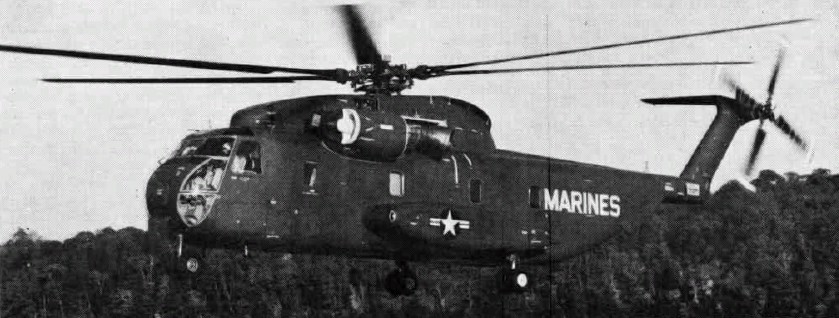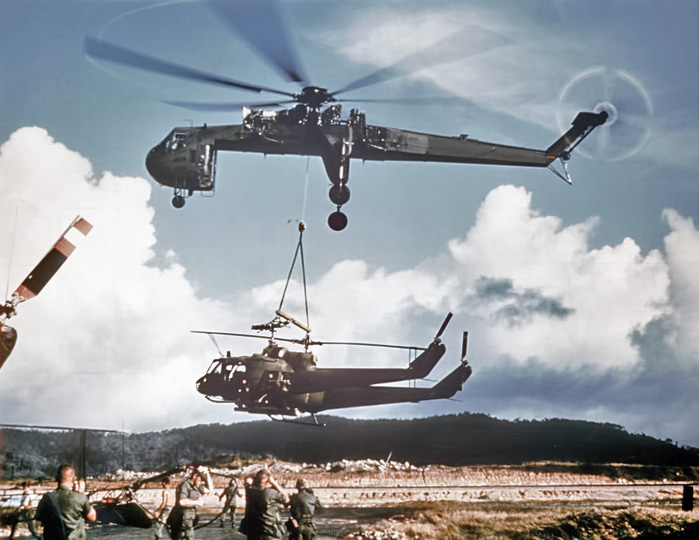|
CH-37
The Sikorsky CH-37 Mojave (company designation S-56) is an American large heavy-lift helicopter of the 1950s. Design and development The S-56 came into being as an assault transport for the United States Marine Corps (USMC), with a capacity of 26 fully equipped Marines. An order for the aircraft was placed in 1951 using the U.S. Navy/U.S. Marine Corps designation of the time of HR2S. The first prototype, the XHR2S-1 flew in 1953 and production deliveries of the HR2S-1 began in July 1956 to Marine Helicopter Squadron One (HMX-1), with a total of sixty aircraft being produced. The United States Army evaluated the prototype in 1954 and ordered 94 examples as the CH-37A, the first being delivered in summer 1956. All Marine Corps and Army examples were delivered by mid-1960. Army examples were all upgraded to CH-37B status in the early 1960s, being given Lear auto-stabilization equipment and the ability to load and unload while hovering. In the 1962 unification of United States ... [...More Info...] [...Related Items...] OR: [Wikipedia] [Google] [Baidu] |
Sikorsky S-60
The Sikorsky S-60 helicopter, a prototype " flying crane", was derived from the S-56 in 1958. Proving to be underpowered, the development of the S-60 led to the larger, turbine-engined Sikorsky CH-54 Tarhe military transport helicopter, and its civil S-64 Skycrane variant, which were already on the drawing board by the time the sole example of the S-60 crashed on 3 April 1961. Design and development In 1958, Sikorsky began designing the S-60 as a prototype " flying crane" helicopter. The S-60 utilized the transmission, rotor system and piston engines from the CH-37/S-56.Donald 1997, p.?Harding 1997, p. 237. The fuselage of the S-60 was a simple "pod-and-boom" design with the engines mounted in side pods and long tailwheel-style landing gear that allowed it to straddle cargoes. The crew cabin was mounted in the nose, with aft-mounted controls for the co-pilot to use during loading and unloading operations. The S-60 had an automatic stabilization system to allow it to hover prec ... [...More Info...] [...Related Items...] OR: [Wikipedia] [Google] [Baidu] |
Sikorsky Aircraft
Sikorsky Aircraft is an American aircraft manufacturer based in Stratford, Connecticut. It was established by aviation pioneer Igor Sikorsky in 1923 and was among the first companies to manufacture helicopters for civilian and military use. Previously owned by United Technologies Corporation, in November 2015 Sikorsky was sold to Lockheed Martin. History On 5 March 1923, the Sikorsky Aero Engineering Corporation was founded near Roosevelt Field, New York, by Igor Sikorsky, an immigrant to the United States who was born in Kyiv. In 1925, the company name was changed to Sikorsky Manufacturing Company. After the success of the Sikorsky S-38">S-38, the company was reorganized as the Sikorsky Aviation Corporation with capital of $5,000,000, allowing the purchase of land and the building of a modern aircraft factory in Stratford. In 1929, the company moved to Stratford, Connecticut, and it became a part of United Aircraft and Transport Corporation (later United Technologies Corporatio ... [...More Info...] [...Related Items...] OR: [Wikipedia] [Google] [Baidu] |
United States Army Aviation Museum
The United States Army Aviation Museum is an aviation museum located on Fort Rucker near Daleville, Alabama. It has the largest collection of helicopters held by a museum in the world.Phillips 1992, p. 37.Purner 2004, p. 204. The museum features some 50 aircraft on public display with aviation artifacts ranging from a replica of the Wright brothers' Model B military biplane to an AH-64 Apache from Operation Desert Storm. The museum has over 160 aircraft in its collection and holds 3,000 historical items. History The museum broke ground on a new building called the Training Support Facility in November 2019. Collection On display Other notable aircraft * Sikorsky S-72 Rotor Systems Research Aircraft (RSRA) * McDonnell XV-1 Convertiplane * Ryan XV-5B Vertifan * Hawker XV-6A Kestrel * Ryan VZ-3RY Vertiplane * YH-41A Seneca * Curtiss-Wright VZ-7 Sources: US Army Aviation Museum collection pages [...More Info...] [...Related Items...] OR: [Wikipedia] [Google] [Baidu] |
Sikorsky CH-53 Sea Stallion
The CH-53 Sea Stallion (Sikorsky S-65) is an American family of heavy-lift transport helicopters designed and built by the American manufacturer Sikorsky Aircraft. It was originally developed in response to a request from the United States Navy's Bureau of Naval Weapons made in March 1962 for a replacement for the Sikorsky CH-37 Mojave helicopters flown by the United States Marine Corps (USMC). In July 1962, Sikorsky's proposal, which was basically a scaled-up S-61R fitted with twin General Electric T64 turboshaft engines and the dynamic system of the S-64/CH-54, was selected. On 14 October 1964, the YCH-53A performed its maiden flight; the first deliveries of production CH-53s to operational units commenced on 12 September 1966. The first combat use of the type occurred during the following year when it was deployed to the Vietnam theatre; the CH-53 quickly proved its value for moving heavy payloads, particularly in the recovery of damaged aircraft. Several variants of the ... [...More Info...] [...Related Items...] OR: [Wikipedia] [Google] [Baidu] |
Sikorsky CH-54 Tarhe
The Sikorsky CH-54 Tarhe is an American twin-engine heavy-lift helicopter designed by Sikorsky Aircraft for the United States Army. It is named after Tarhe, an 18th-century chief of the Wyandot Indian tribe whose nickname was "The Crane". The civil version is the Sikorsky S-64 Skycrane. Development Work on what would become the CH-54 can be traced back to Sikorsky's earlier activities with "sky-crane" helicopters, particularly the piston-engined Sikorsky S-60 of the late 1950s. Following the end of the Korean War, the United States Army sought to procure a successor to the Sikorsky CH-37 Mojave, an early piston-engined heavily lift helicopter; being aware of this need, Sikorsky were keen to fulfil it. The company was already working on the Sikorsky S-64 Skycrane, a civil-orientated heavy lift rotorcraft that was designed specifically for the purpose of carrying large payloads externally; the development of a military-configured derivative was viewed as a natural option. Whi ... [...More Info...] [...Related Items...] OR: [Wikipedia] [Google] [Baidu] |
Pratt & Whitney R-2800 Double Wasp
The Pratt & Whitney R-2800 Double Wasp is an American twin-row, 18-cylinder, air-cooled radial aircraft engine with a displacement of , and is part of the long-lived Wasp family of engines. The R-2800 saw widespread use in many important American aircraft during and after World War II. During the war years, Pratt & Whitney continued to develop new ideas to upgrade the engine, including water injection for takeoff in cargo and passenger planes and to give emergency power in combat. Design and development First run in 1937, near the time that the larger competing 18-cylinder Wright Duplex-Cyclone's development had been started in May of that year, the displacement R-2800 was first-flown by 1940, one year before the Duplex-Cyclone. The Double Wasp was more powerful than the world's only other modern 18-cylinder engine, the Gnome-Rhône 18L of . The Double Wasp was much smaller in displacement than either of the other 18-cylinder designs, and heat dissipation was a greate ... [...More Info...] [...Related Items...] OR: [Wikipedia] [Google] [Baidu] |
Westland Westminster
The Westland Westminster was a British helicopter of the 1950s from Westland Aircraft. A large cargo design, it was powered by two turboshaft engines driving a single, five-bladed rotor. Initially unclad, the all-metal airframe was later enclosed in a fabric covering. Designed and built as a private venture without government assistance, it was cancelled when Westland took over rival helicopter producers and their more advanced projects. Development The Westminster was the first tangible result of efforts that Westland Aircraft had been making throughout the 1950s to produce a gas-turbine-powered heavy-lift helicopter. Projects ranged up to the remarkable W.90, a 450-seat troopship with three Armstrong Siddeley Sapphire turbojets mounted on its rotor-tips.James 1991, p.498. In 1954, Westland investigated licensed manufacture of the Sikorsky S-56 for the civil market with turboshaft power. The company sought Ministry of Supply support for the proposal, but this was not forthcom ... [...More Info...] [...Related Items...] OR: [Wikipedia] [Google] [Baidu] |
Westland Aircraft
Westland Aircraft was a British aircraft manufacturer located in Yeovil, Somerset. Formed as a separate company by separation from Petters Limited just before the start of the Second World War, Westland had been building aircraft since 1915. During the war the company produced a number of generally unsuccessful designs, but their Lysander would serve as an important liaison aircraft with the Royal Air Force. After the war the company focused on helicopters, and was merged with several other British firms to create Westland Helicopters in 1961. History Foundation In 1915 the Westland Aircraft Works was founded as a division of Petters in response to government orders for the construction under licence of initially 12 Short Type 184 seaplanes, followed by 20 Short Admiralty Type 166. Orders for other aircraft followed during First World War, including the Sopwith 1½ Strutter, the de Havilland designed Airco DH.4, Airco DH.9 and Airco DH.9A and the Vickers Vimy. The name ... [...More Info...] [...Related Items...] OR: [Wikipedia] [Google] [Baidu] |
Napier Eland
The Napier Eland was a British turboshaft or turboprop gas-turbine engine built by Napier & Son in the early 1950s. Production of the Eland ceased in 1961 when the Napier company was taken over by Rolls-Royce. Design and development The Eland was first tested in 1953 in a Vickers Varsity aircraft. Further flight proving was carried out from 1955 using the first production Airspeed Ambassador 2. The Eland was dropped from production when Napiers was acquired by Rolls-Royce Limited in 1961. The Eland was used to power various aircraft including the Westland Westminster heavy-lift helicopter, the Canadair CL-66; a turbine-powered version of the Convair CV-340 for the Canadian military(later converted to Allison T-56 propjets after a number of engine failures), and the Fairey Rotodyne gyrodyne. In the Rotodyne, the Eland powered the tractor propellers for forward flight and a compressor, via a clutch and shaft arrangement, to feed the rotor tip-jets with compressed air for vert ... [...More Info...] [...Related Items...] OR: [Wikipedia] [Google] [Baidu] |
Fuselage
The fuselage (; from the French ''fuselé'' "spindle-shaped") is an aircraft's main body section. It holds crew, passengers, or cargo. In single-engine aircraft, it will usually contain an engine as well, although in some amphibious aircraft the single engine is mounted on a pylon attached to the fuselage, which in turn is used as a floating hull. The fuselage also serves to position the control and stabilization surfaces in specific relationships to lifting surfaces, which is required for aircraft stability and maneuverability. Types of structures Truss structure This type of structure is still in use in many lightweight aircraft using welded steel tube trusses. A box truss fuselage structure can also be built out of wood—often covered with plywood. Simple box structures may be rounded by the addition of supported lightweight stringers, allowing the fabric covering to form a more aerodynamic shape, or one more pleasing to the eye. Geodesic construction Geo ... [...More Info...] [...Related Items...] OR: [Wikipedia] [Google] [Baidu] |
Prototype
A prototype is an early sample, model, or release of a product built to test a concept or process. It is a term used in a variety of contexts, including semantics, design, electronics, and Software prototyping, software programming. A prototype is generally used to evaluate a new design to enhance precision by system analysts and users. Prototyping serves to provide specifications for a real, working system rather than a theoretical one. In some design workflow models, creating a prototype (a process sometimes called materialization) is the step between the Formal specification, formalization and the evaluation of an idea. A prototype can also mean a typical example of something such as in the use of the derivation 'prototypical'. This is a useful term in identifying objects, behaviours and concepts which are considered the accepted norm and is analogous with terms such as stereotypes and archetypes. The word ''wikt:prototype, prototype'' derives from the Greek language, Greek ... [...More Info...] [...Related Items...] OR: [Wikipedia] [Google] [Baidu] |









